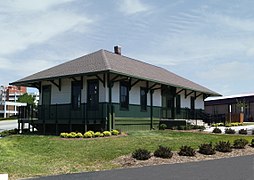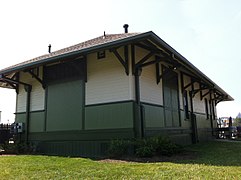The Jeffersonville, Madison and Indianapolis Railroad (JM&I) was formed in 1866 as a merger between the Indianapolis and Madison Railroad and the Jeffersonville Railroad.
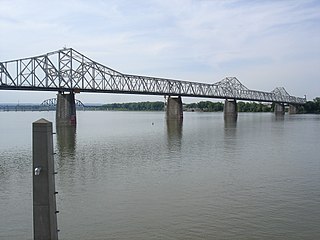
The George Rogers Clark Memorial Bridge, known locally as the Second Street Bridge, is a four-lane cantilevered truss bridge crossing the Ohio River between Louisville, Kentucky, and Jeffersonville, Indiana, that carries US 31.

The Old Jeffersonville Historic District is located in Jeffersonville, Indiana, United States. It marks the original boundaries of Jeffersonville, and is the heart of modern-day downtown Jeffersonville. It was placed on the National Register of Historic Places in 1983. The area is roughly bounded by Court Avenue at the North, Graham Street on the east, the Ohio River at the south, and Interstate 65 at the west. In total, the district has 203 acres (0.8 km2), 500 buildings, 6 structures, and 11 objects. Several banks are located in the historic buildings in the district. The now defunct Steamboat Days Festival, held on the second weekend in September, used to be held on Spring Street and the waterfront. Jeffersonville's largest fire wiped out a block in the historic district on January 11, 2004 which destroyed the original Horner's Novelty store.
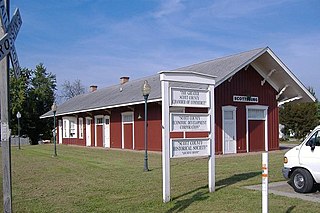
Scottsburg is a historic railroad depot located at Scottsburg, Scott County, Indiana. It was built in 1872 by the Jeffersonville, Madison and Indianapolis Railroad, costing almost $1,492. It is a one-story, Stick Style frame building with board and batten siding and a projecting agent's window. Its presence influenced the location of Scottsburg in 1874, as the town was named for the railroad's General Superintendent, Horace Scott. It was built specifically for both passenger and freight cargo. Inside there was separate waiting rooms for men and women. Passenger service to the station ended in the 1950s. It is one of the last structures of its kind still standing in Indiana.

Lafayette station is an Amtrak station in Lafayette, Indiana, served by the Cardinal. The current station facility was established in 1994. The Amtrak train previously stopped in the middle of the city's 5th Street, near the former Monon Railroad depot. The station building was moved to its current location from the southeast corner of 2nd and South streets in September 1994. It is a Romanesque Revival style depot built in 1902 by the Lake Erie and Western Railroad and Cleveland, Cincinnati, Chicago and St. Louis Railway, as the Big Four Depot. The station was listed on the National Register of Historic Places in 2003.

The Cincinnati, Richmond & Muncie Depot is a restored train station in Muncie, Indiana, United States. Built in 1901, it was acquired by the Chesapeake and Ohio Railway in 1910. The station was used for passenger train service throughout the 20th century and was added to the National Register of Historic Places in 1997. It is currently used as a visitor center and office for the adjacent Cardinal Greenway.

Beverly Shores is a train station in Beverly Shores, Indiana, served by the South Shore Line interurban commuter railroad. The station serves the town of Beverly Shores as well as the nearby Town of Pines. It is a flag stop.

The Southern Indiana Railroad Freighthouse, located in Seymour, Indiana, has since January 2008 served as the Jackson County Visitor Center, for Jackson County, Indiana. This freight house was placed on the National Register of Historic Places on June 22, 2003.

Bedford Depot is a historic railroad depot in Bedford, Massachusetts, United States. Bedford was the junction of the Reformatory Branch and the Lexington Branch of the Boston and Maine Railroad; it saw passenger service until 1977 as the stub of the Lexington Branch. The original 1874 depot and 1877 freight house are listed on the National Register of Historic Places; along with a restored Budd Rail Diesel Car, they form the centerpieces of the Bedford Depot Park.

The Nashville, Chattanooga, and St. Louis Railway Office and Freight House, simply known as the Paducah Freight House, is a historic railroad freight depot located in the southern portion of downtown Paducah, Kentucky.

The Medora Covered Bridge was the longest covered bridge in the United states with the entire original historic truss still in place with some repairs but no structural changes. Measuring the clear span of 431 feet 10 inches (131.62 m), the Medora Covered Bridge is the longest historic covered bridge in the United States. The roof length of 461 feet (141 m) and the siding at the floor length of 459 feet (140 m) are also the longest historic covered bridge measurements in the U.S.

Berkeley Springs station is a historic railway depot located at Berkeley Springs, Morgan County, West Virginia. The depot is a one-story, rectangular red brick building with a bell-cast, red tile roof and measures approximately 80 feet long by 20 feet wide. It features Mission Revival style details.

The James Elliott Farm is a historic farmstead located on the edge of the town of New Harmony in Posey County, in the U.S. state of Indiana. The farm is composed of the farmhouse and seven outbuildings, including corn cribs, a barn, a shed, a silo, and a milkhouse. The farm centers around the farmhouse, which was built in the Greek Revival style in 1826 by English immigrant James Elliott; even before Elliott joined the commune, the property had been associated with the followers of Robert Owen; the land had previously supported an offshoot of the main community, which its residents called "Feiba Peveli." Elliott had settled in the vicinity as part of the Owenist commune that lived at New Harmony at that time; besides farming, Elliott established himself as the community's brewer.

The Bloomington freight station is a historic train station in downtown Bloomington, Indiana, United States. Constructed in the early twentieth century, it has endured closure and a series of modifications to survive to the present day, and it has been declared a historic site. Used only occasionally for many years, it is one of the most important buildings in a large historic district on the city's west side.

Downtown Lafayette Historic District is a national historic district located at Lafayette, Tippecanoe County, Indiana. Lafayette began in 1825 as a transportation center for the west central area of Indiana. Its development and growth reflects the changes in transportation over the intervening years. From its location along the Wabash River, it grew first with river travel then for a short while from the Wabash and Erie Canal. When the railroads arrived in the 1850s, the town began to grow, initially along the rail lines. The Downtown Lafayette Historic District reflects these early changes.

Chesterton is a disused train station in Chesterton, Indiana. The current depot replaced a wooden structure built in 1852 for the Northern Indiana and Chicago Railroad, a predecessor road of the Lake Shore and Michigan Southern Railway, that burned down in 1913. It was rebuilt in 1914 as a brick structure. By 1914, Cornelius Vanderbilt of the New York Central and Hudson River Railroad held a majority interest in the Lake Shore and Michigan Southern Railway. The Southern Railways trackage provided an ideal extension of the New York Central from Buffalo to Chicago. On December 22, 1914, the New York Central and Hudson River Railroad merged with the Lake Shore and Michigan Southern Railway to form a new New York Central Railroad.

Joel Jessup Farm is a historic home and farm located in Guilford Township, Hendricks County, Indiana. The farmhouse was built about 1864, and is a two-story, Italianate style brick I-house with a rear kitchen ell. It has a slate gable roof, round arched windows, and multiple brick chimneys. Also on the property are the contributing traverse frame barn and privy.

Bloomington West Side Historic District is a national historic district located at Bloomington, Monroe County, Indiana. The district encompasses 394 contributing buildings, 2 contributing sites, and 2 contributing structures in a mixed residential, commercial, and industrial section of Bloomington. It developed between about 1850 and 1946, and includes notable examples of Queen Anne and Bungalow/American Craftsman style architecture. Located in the district are the separately listed Elias Abel House, Cantol Wax Company Building, Coca-Cola Bottling Plant, Cochran-Helton-Lindley House, Illinois Central Railroad Freight Depot, Johnson's Creamery, and Second Baptist Church. Other notable contributing resources include the Works Progress Administration constructed wading pool, White Oak Cemetery, Ninth Street Park, Bloomington Wholesale Foods Warehouse, Bloomington Garage, Curry Buick, Banneker School, Bethel African Methodist Episcopal Church, and Bloomington Frosted Foods.
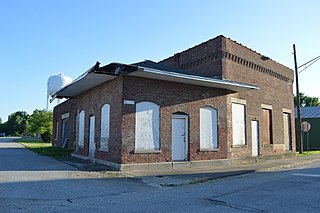
Shelburn Interurban Depot-THI&E Interurban Depot is a historic interurban train station located at Shelburn, Sullivan County, Indiana. It was built about 1911 and enlarged between 1916 and 1920. It is a one-story, red brick and limestone building that housed passenger and freight rooms and a substation for the electrical system that powered the interurban cars. It was used for its original purpose until the closure of the interurban line between Terre Haute, Indiana and Sullivan in May 1931.
P. C. C. & St. L. Railroad Freight Depot, also known as the Central Union Warehouse, was a historic freight depot located at Indianapolis, Marion County, Indiana. It was built in 1916 by the Pittsburgh, Cincinnati, Chicago and St. Louis Railroad. It was a one-story, brick warehouse building measuring 790 feet long and 70 feet wide. It has been demolished.







